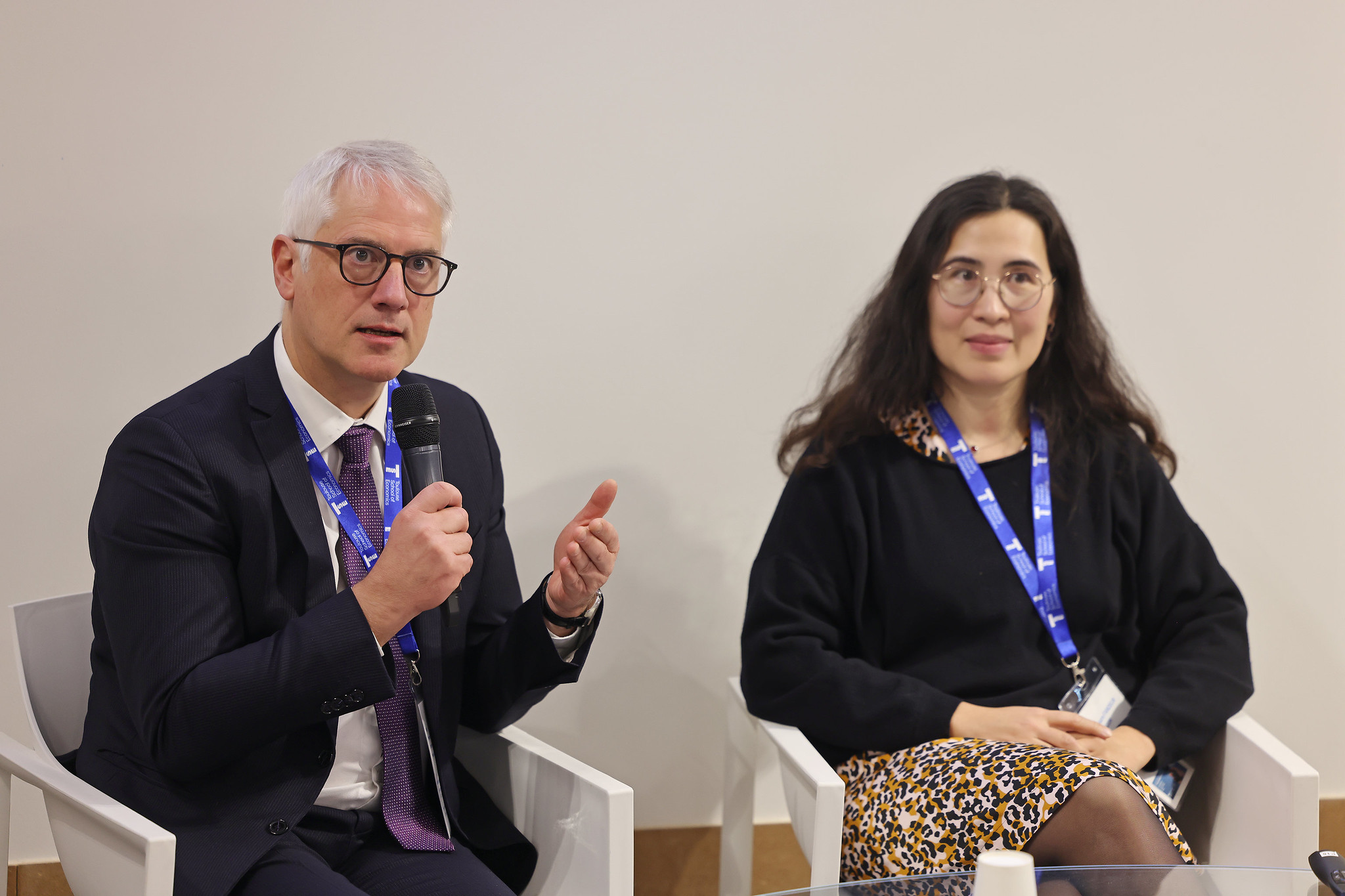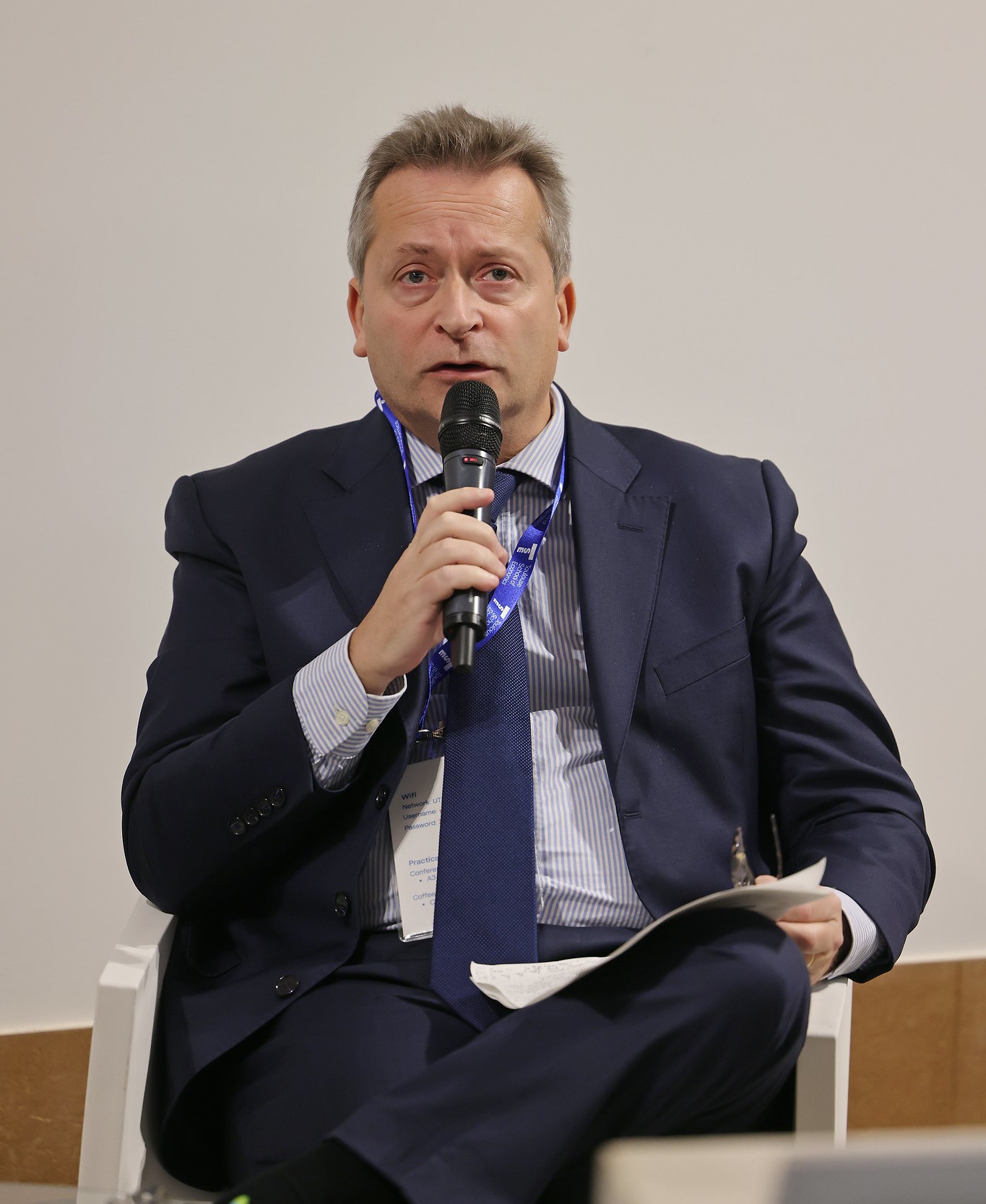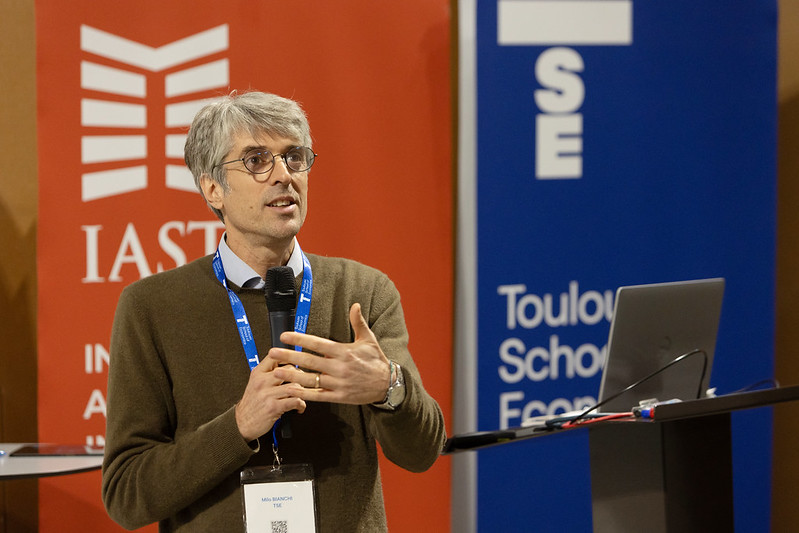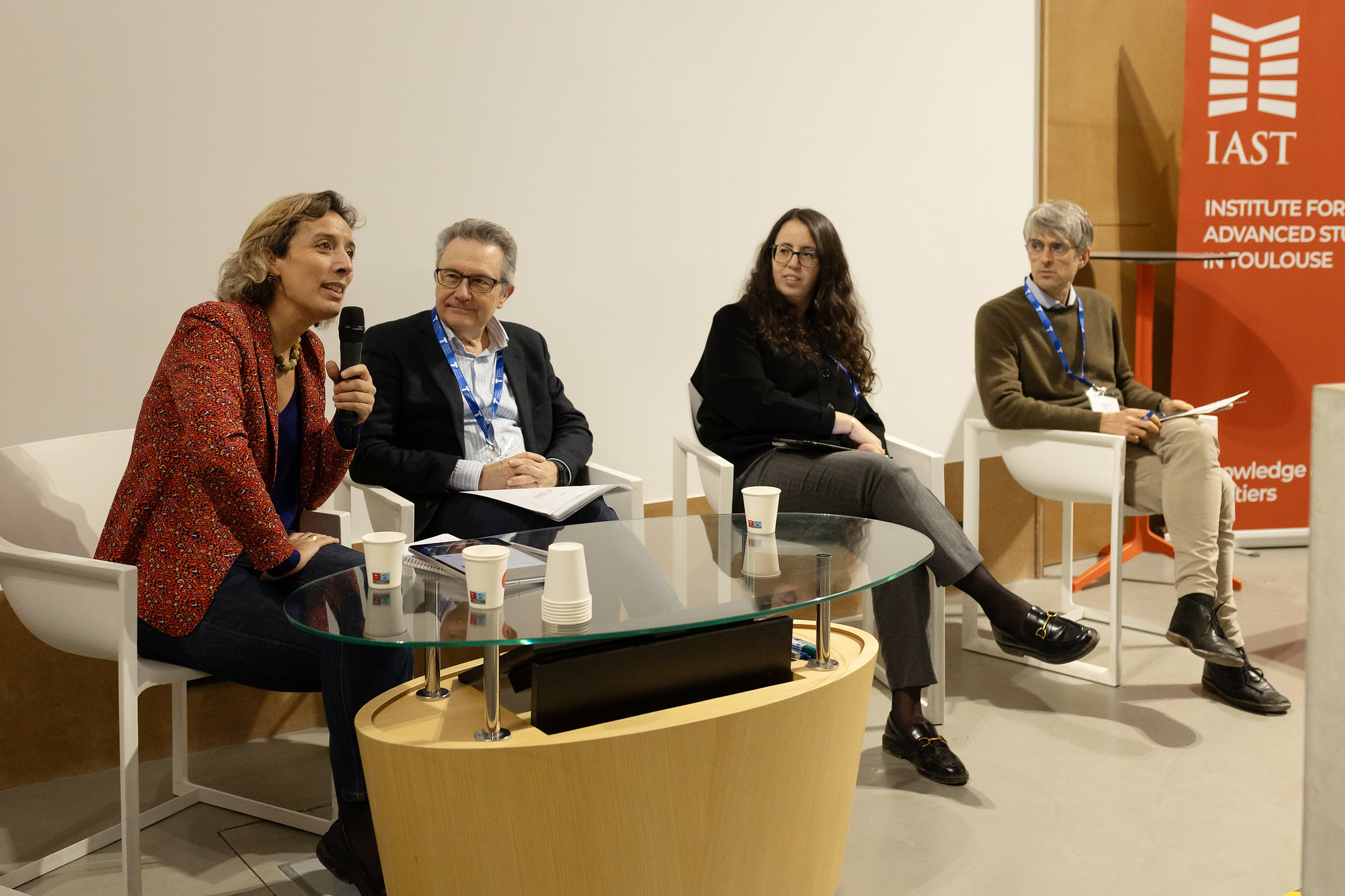TSE held the 3rd edition of its Sustainable Finance Conference on December 7th and 8th in Toulouse.
In the same vein as the two previous editions, this conference provided a platform to delve into recent scientific contributions that enhance our understanding of sustainable finance and its implications for modern society. Presentations and discussions at the conference covered a large range of topics, such as climate risks and regulation in finance, financial stability, privacy issues, fintech and the AI revolution in finance.
The event featured two panel discussions with representatives from distinguished institutions and companies in the banking and finance sectors, as well as academics associated with TSE.
We express our gratitude to all participants for their active involvement and enthusiasm in fostering connections among researchers, regulators, and practitioners. Additionally, we extend our thanks to the partners of the TSE Sustainable Finance Center for their support. Looking ahead, we are excited to announce our upcoming conferences on sustainable finance in May: Financial Inclusion Through Interoperability Conference (TSE), Biodiversity & Climate Conference (Banque de France).
1st Panel discussion, Thursday 7
“Climate risks and regulation”
In a session led by TSE researcher Sophie Moinas, a public supervisor alongside representatives from the corporate sector and academia, provided valuable insights into the latest advancements in measuring companies' vulnerability to climate change. The discussion illuminated the challenges that need attention and outlined the subsequent steps to be undertaken.
 Because insurance or reinsurance companies have probably been among the first to be aware that they would directly be impacted by climate change and its consequences on the frequency of extreme events, and because they allocate significant resources to risk research, they have developed expertise on quantifying these exposures. Marie-Laure Fandeur, Head of P&C ESG at SCOR, described the company’s integrated use of hazard, vulnerability, and financial modules in assessing risks. “Sustainability is a mix of self-adopted constraints relating to our ambition and legal obligations linked to European Union legislations,” she said, also noting the push from the EU regulation to be more transparent is viewed favorably by a reinsurer such as SCOR. Besides the EU taxonomy and the Corporate Sustainability Reporting Directive, SCOR also works with the regulator in the context of stress tests.
Because insurance or reinsurance companies have probably been among the first to be aware that they would directly be impacted by climate change and its consequences on the frequency of extreme events, and because they allocate significant resources to risk research, they have developed expertise on quantifying these exposures. Marie-Laure Fandeur, Head of P&C ESG at SCOR, described the company’s integrated use of hazard, vulnerability, and financial modules in assessing risks. “Sustainability is a mix of self-adopted constraints relating to our ambition and legal obligations linked to European Union legislations,” she said, also noting the push from the EU regulation to be more transparent is viewed favorably by a reinsurer such as SCOR. Besides the EU taxonomy and the Corporate Sustainability Reporting Directive, SCOR also works with the regulator in the context of stress tests.
Laurent Clerc, Director for Research and Risk Analysis at Autorité de Contrôle Prudentiel et de Résolution (ACPR) presented the regulatory framework in place in France for banks and insurers on climate-change related issues. From a supervisory entity’s point of view, climate-change-related issues are primarily assessed from a risk management/ financial stability perspective: transition, physical, and operational (legal, liability, reputation, model…) risks, as well as client protection (provision of new financial services or products). However, the current regulatory framework mostly focuses on disclosing non-financial information. “We are witnessing a regulatory tsunami, which can be seen as a risk in itself,” said Laurent Clerc. If there was a pioneering French setting (e.g., with the 2015 Green Transition and Green Growth Act and the Energy and Climate Law of 2019, which came into force in 2022), much is now happening at the European and international levels. Laurent Clerc then shared the ACPR's approach to raising the awareness of financial institutions and their effective management of climate-related risks. Among recent actions, he mentioned the joint AMF-ACPR 3rd report on “Monitoring and assessment of market participants' climate commitments,” and he went through the features of the climate stress exercise focused on the insurance sector that ACPR started in July 2023, after a first pilot exercise 3 years ago, with banks and insurance companies.
 Jean-Philippe Desmartin, Head of Responsible Investment at Edmond de Rothschild Asset Management, shared their experience as a European investor. In 2017, the Task Force on Climate-related Financial Disclosures (TCFD) provided a simple way to address climate risks and opportunities. In the past, his asset management company faced the challenge of developing its first climate change roadmap with zero data. In recent years, much has improved: management tools have been implemented — thanks to a collaboration with Carbon4 Finance, which provides financial institutions with a complete set of climate and biodiversity data solutions enabling them to play a role in a fair transition that respects climate and nature. Now, there exist major differences in positioning among large financial institutions when comparing their choices regarding their exposure to fossil energy and investments in renewable energies. Edmond de Rothschild Asset Management strives to achieve net zero greenhouse gas (GHG) emissions by 2050 as part of the company’s commitment to the Net Zero Asset Managers Initiative (NZAM). “After a period of progress through market and regulation between 2017 and 2024, we are now in a period of disillusionment as practitioners because of the complexity and instability of the situation we are facing. We must deal with contradictions and an unstable situation. As an exemple, in September, Brussels announced a potential complete revision of the FSDR regulation” said Jean-Philippe Desmartin, wondering how to articulate the various regulatory frameworks financial institutions must adjust to, though optimistic about the future.
Jean-Philippe Desmartin, Head of Responsible Investment at Edmond de Rothschild Asset Management, shared their experience as a European investor. In 2017, the Task Force on Climate-related Financial Disclosures (TCFD) provided a simple way to address climate risks and opportunities. In the past, his asset management company faced the challenge of developing its first climate change roadmap with zero data. In recent years, much has improved: management tools have been implemented — thanks to a collaboration with Carbon4 Finance, which provides financial institutions with a complete set of climate and biodiversity data solutions enabling them to play a role in a fair transition that respects climate and nature. Now, there exist major differences in positioning among large financial institutions when comparing their choices regarding their exposure to fossil energy and investments in renewable energies. Edmond de Rothschild Asset Management strives to achieve net zero greenhouse gas (GHG) emissions by 2050 as part of the company’s commitment to the Net Zero Asset Managers Initiative (NZAM). “After a period of progress through market and regulation between 2017 and 2024, we are now in a period of disillusionment as practitioners because of the complexity and instability of the situation we are facing. We must deal with contradictions and an unstable situation. As an exemple, in September, Brussels announced a potential complete revision of the FSDR regulation” said Jean-Philippe Desmartin, wondering how to articulate the various regulatory frameworks financial institutions must adjust to, though optimistic about the future.
Sébastien Pouget, professor of Finance at TSE, challenged the regulation as well, raising questions related to the link between the various regulations (including CSDR and FSDR regulations) and the trade-off between financial stability and the need to introduce new climate regulations.
The questions were raised during the Q&A session. A member of the audience highlighted the unique position of insurers who have people insured against climate change and must, at the same time, do something about climate change. In reaction to this, Marie-Laure Fandeur stresses the need for public and private actions to address climate change and transition issues. However, for Laurent Clerc, even if increasing costs and frequency will make climate risk uninsurable, transferring the risk to the State is not a simple answer to this issue.
The audience was curious to learn more about the transition risk, and the articulation betwee n the various layers of regulation. For instance, is the taxonomy helping investors? The panel participants agreed that there has been a lot of impetus to implement a regulatory framework in Europe. The Taxonomy was supposed to help investors and sustainable finance companies. For Laurent Clerc, because of the delays and complexity of the EU regulations, the Taxonomy, in fact, is far more demanding than expected, and it is not efficient in practice. For Jean-Philippe Desmartin, a human resource allocation challenge is raised here: "Dealing with EU regulations such as the Taxonomy or CSRD is quite demanding for a firm (corporates have a thousand metrics to report on!) while investors simultaneously need to allocate resources for the urgent transition." What about the articulation between US and European regulation? It is indeed key for investors who are involved worldwide. Should we get prepared both for the US and Europe’s ambition or comply with EU’s ambitions? Laurent Clerc mentioned that the US and European standards are aligned to more than 80%.
n the various layers of regulation. For instance, is the taxonomy helping investors? The panel participants agreed that there has been a lot of impetus to implement a regulatory framework in Europe. The Taxonomy was supposed to help investors and sustainable finance companies. For Laurent Clerc, because of the delays and complexity of the EU regulations, the Taxonomy, in fact, is far more demanding than expected, and it is not efficient in practice. For Jean-Philippe Desmartin, a human resource allocation challenge is raised here: "Dealing with EU regulations such as the Taxonomy or CSRD is quite demanding for a firm (corporates have a thousand metrics to report on!) while investors simultaneously need to allocate resources for the urgent transition." What about the articulation between US and European regulation? It is indeed key for investors who are involved worldwide. Should we get prepared both for the US and Europe’s ambition or comply with EU’s ambitions? Laurent Clerc mentioned that the US and European standards are aligned to more than 80%.
Sébastien Pouget closed the panel with a word of encouragement for all those who work on measuring climate risks and social impact. Finding a double-entry accounting method took considerable time, and finding metrics on ESG sustainable impact is still an ongoing process that raises very complex issues. Yet, the urgency of addressing climate change provides an incentive to encourage and accelerate research efforts in developing indicators.
2nd Panel discussion, December 8
“AI in finance”
 The "AI in Finance" roundtable was crafted to delve into the evolving landscape of AI application within the financial sector, emphasizing both positive contributions and responsible utilization in the finance profession. In his opening words, panel moderator and TSE researcher Milo Bianchi acknowledged the diverse perspectives surrounding recent AI developments. He noted, “We sometimes find ourselves between those who think that recent developments in AI are paving the way towards a bright future in which AI will help us solve the greatest issues of humankind, and more catastrophic views in which the mere existence of humankind will be threatened by super intelligent robots.” To steer the discussion back to the core theme of AI in finance, Milo Bianchi posed questions to the panelists regarding the transformation of their roles due to AI, the potential improvements AI can bring to our lives, and the risks and challenges associated with AI utilization. Questions such as whether AI poses a threat to financial stability, how it can enhance the monitoring and quantification of risks (including climate-risk exposures), and in what ways it can help direct investments towards more sustainable companies were explored.
The "AI in Finance" roundtable was crafted to delve into the evolving landscape of AI application within the financial sector, emphasizing both positive contributions and responsible utilization in the finance profession. In his opening words, panel moderator and TSE researcher Milo Bianchi acknowledged the diverse perspectives surrounding recent AI developments. He noted, “We sometimes find ourselves between those who think that recent developments in AI are paving the way towards a bright future in which AI will help us solve the greatest issues of humankind, and more catastrophic views in which the mere existence of humankind will be threatened by super intelligent robots.” To steer the discussion back to the core theme of AI in finance, Milo Bianchi posed questions to the panelists regarding the transformation of their roles due to AI, the potential improvements AI can bring to our lives, and the risks and challenges associated with AI utilization. Questions such as whether AI poses a threat to financial stability, how it can enhance the monitoring and quantification of risks (including climate-risk exposures), and in what ways it can help direct investments towards more sustainable companies were explored.
Marie Briere, Head of Investor Intelligence and Academic Partnerships at Amundi Institute in Paris and also Chairman of the Institute for Quantitative Investment Research (Inquire Europe) and of the Scientific Committee of the European Savings Observatory, talked about the use of AI from the perspective of an asset manager, and in particular on how AI can help (or not) design and implement sustainable investment decisions. She shared use cases of AI in sustainable finance and illustrated that “AI can be used to build additional data sets that can help asset managers”. AI enables asset managers to check what companies are saying and to measure things differently. It is now possible to use alternative sources of data (text and sound, image, others…) with different technologies (web scraping, NLP, speech recognition, computation vision etc.). Amundi has been using AI to measure climate sentiment. “AI can also be used to measure the credibility of companies’ concrete commitments and for greenwashing detection”. She emphasized that there have been significant recent developments, particularly in NLP (Natural Language Processing), enabling coverage of new documents. AI can be useful when we try to estimate scope 3 emissions. Satellite imagery can also help to verify firms’ carbon emissions or analyze the impact of their activity on ecosystems. On a broader approach, they can help measure the impact of natural disasters and build social indicators.
Xavier Vives, Professor of Economics and Finance, academic director of the Public-Private Research Center at IESE Business School and affiliated member of TSE talked about the influence of AI in banking and specifically in lending and how it affects competition and stability.
 TSE alumna and Chief Economist and Director of the Analysis, Financial Stability and Risk Division at French Financial Markets Authority (AMF) Kheira Benhami presented the regulatory perspective and talked about the use of AI for regulation. She highlighted new opportunities for enhanced supervisory tools. “Over the past five years, we've undergone a comprehensive transformation of all our IT platforms to effectively accommodate this evolving landscape”. AI allows “a big jump in terms of efficiency”. The use of AI by AMF is important for investor protection issues. It can help detect scams and fraudulent sites. “The regulator also uses AI to see how market participants fulfill their obligations.” For instance, the AMF uses natural language processing (NLP), to check if participants respect their reporting obligations. “This entails creativeness on the way”. Kheira Benham assured that the AMF would work more on this in the future. “AMF is an innovation friendly regulator” she said. AMF has been using and developing data processing tools long ago, has investigated the crypto-assets topic rapidly, is now working more and more on the open data topics etc. The AMF teams are supportive of the sandbox approach.
TSE alumna and Chief Economist and Director of the Analysis, Financial Stability and Risk Division at French Financial Markets Authority (AMF) Kheira Benhami presented the regulatory perspective and talked about the use of AI for regulation. She highlighted new opportunities for enhanced supervisory tools. “Over the past five years, we've undergone a comprehensive transformation of all our IT platforms to effectively accommodate this evolving landscape”. AI allows “a big jump in terms of efficiency”. The use of AI by AMF is important for investor protection issues. It can help detect scams and fraudulent sites. “The regulator also uses AI to see how market participants fulfill their obligations.” For instance, the AMF uses natural language processing (NLP), to check if participants respect their reporting obligations. “This entails creativeness on the way”. Kheira Benham assured that the AMF would work more on this in the future. “AMF is an innovation friendly regulator” she said. AMF has been using and developing data processing tools long ago, has investigated the crypto-assets topic rapidly, is now working more and more on the open data topics etc. The AMF teams are supportive of the sandbox approach.
Asked by the audience about tangible success stories in finance or the investment world involving AI, Marie Brière spoke about clients’ concerns on AI driven funds. “We can use AI indicators, but the asset manager is the decision taker”. In the end, they are the person responsible for success or failure. There is indeed a human responsible for interpreting the results. The adage “don’t invest in something you don’t understand” remains valid.
The discussion concluded with a focus on the ongoing deliberations regarding the European proposal for a legal framework on AI, these deliberations being of significant interest to all stakeholders in AI, both within the finance sector and beyond.
Published in TSE Reflect, February 2024

